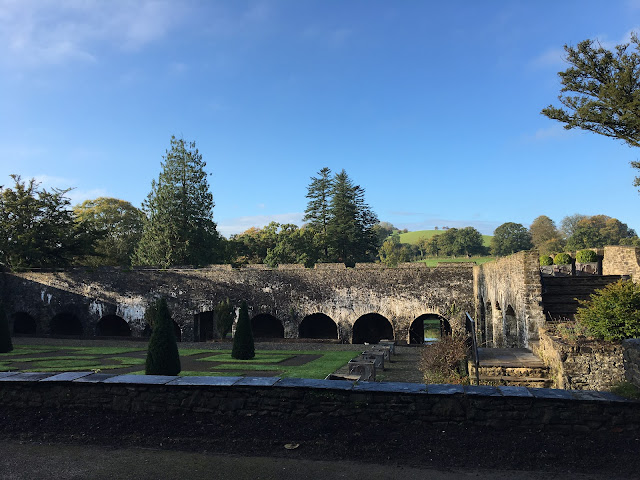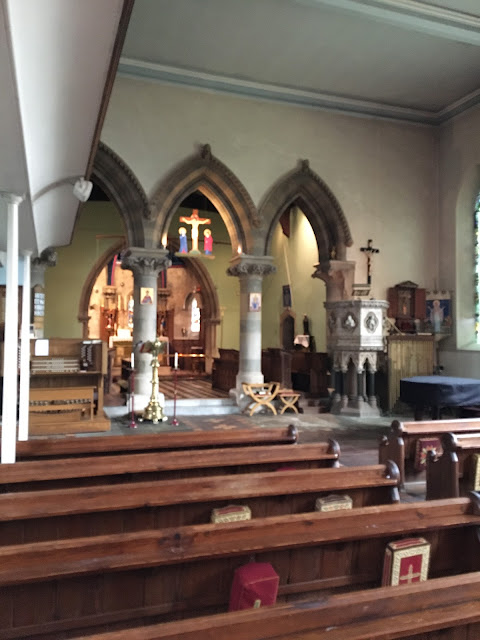On our brief visit to Brecon the other month we found time to pop into that excellent second-hand bookshop 'Brecon Books'. I rather over-spent on books that day, but I did find a copy of 'Sir Ninian Comper: An Introduction to his Life and Work' by Fr Anthony Symondson. It was published in 2006. As regular readers of this blog will know Comper is one of my favourite architects. Apologies in advance if this post gets too arcane.
'Philosphy helps, from Plato onwards, because it puts beauty in the right place as one of the three eternal values equal with truth and goodness so what applies to one of them is true of the others.'
Sir John Ninian Comper, so Fr Anthony Symondson writes in this fascinating and long needed book 'sought beauty in a life-long quest'. I have chosen this quote to illustrate that Comper not only participated in the sensuous world but also that of the mind, and the spirit. He was, for example, well-traveled and well read. Comper's quest was a lengthy one; he was born in 1864 and died in 1960, aged 96 and with work incomplete. He was perhaps the greatest church architect working in Britain in the first half of the twentieth century, and was extraordinarily prolific; although designing a mere 18 or so churches & chapels he produced a myriad of church furnishings, stained glass and vestments. This enormous productivity means of course, that some of his work is better than others - this particularly true of the work he produced in his old age - but at his best work dazzles and entrances. Some of it, I would argue, approaches the sublime. Of Comper's masterpiece St Mary, Wellingborough, the critic and historian John Julius Norwich wrote: 'All is confidence and conviction, the work of a man who was not afraid to take one gigantic breath of all he knew about architecture and all he felt about God, and let it all out together in one great bellow of praise.'
I suppose Comper isn't much thought of or about much these days - that is after all the fate of the overwhelming number of architects unless you're, say, Sir Christopher Wren. He seems to be the architect most people have heard of, at least in the British Isles. The paradox of course, is that Comper's work is very widely known indeed. It was seen across the world at both the Lying-in-State of the late Queen, and at her State Funeral and at the Coronation of her son. Such, I suppose is the nature of fame, or lack thereof.
Comper is an architect, though, that has divided the critics. Betjeman was a fan (of sorts), as was the artist John Piper. Kenneth Clarke offered an equivocal critical support. In general the Modernists were not in approval. Pevsner on the whole was not a fan; of St Cyprian's Clarence Gate he said, "If there must be medieval imitation in the twentieth century, it is here unquestionably done with joy and care" and "there is no reason for the excesses of praise lavished on Comper's church furnishings by those who confound aesthetic with religious emotions" (Ouch!); however of St Mary's Wellingborough, "It glistens and reveals to the heart's content." Timothy Mowl said dismissively of Comper that 'he may or may not have been the most impressive British church architect of the twentieth century, but he was the most gloriously camp.'
I must have been in my late teens when I first came across his work through reading the work of Sir John Betjeman in particular the Introduction to the 'Collins Guide to Parish Churches', and I was waxing in Anglo-Catholicism. My first actual encounter with his work was in the little church of St Mary in Great Ryburgh, deep in rural north Norfolk, where to my surprise there were battered copies of the English Missal in the pews. Just why do Norfolk churches smell and feel so different from everywhere else? My second in the Edwardian church of All Saints, Lincoln. There was nothing particularly 'camp' in either church, or for that matter in the pristine austerity of either St Philip's, Cosham; or the All Saints Covent Chapel, at London Colney.
Comper was born in Aberdeen of English parents. His father, the Rev'd John Comper, was a priest in the Scottish Episcopal Church - a friend of John Mason Neale and a slum priest in the Tractarian tradition. He was also a writer, and I think it one his books, 'A Handbook on the Origin, History, and Structure of Liturgies', which may help explain the intellectual outlook of his son. This book, which strikes me as generous in its outlook, forms part of a long stream of Anglican thought that looked back to the early church for inspiration. All newly founded Protestant churches made similar statements at the Reformation, but Anglicanism is the only one that took this claim seriously. It was there in the work some of the Laudians, definitely there with the Nonjurors and it was there in the Scottish Episcopal Church, which in the mid-eighteenth century, had revised The Book of Common Prayer along 'primitive' lines. And it was there too in the considerable unwritten liturgical tradition of the Episcopal church, particularly in the North-east of Scotland, that included such practices as the Dismissal of the Catechumens during the eucharist. Comper also took from his youth in Scotland a continuing interest in the architecture of Late Medieval Scotland. This is something that is not picked up in the book, but such details, like reticulated tracery and gabled buttresses which had remained in the Scottish architectural vocabulary long after they had been dropped south of the border, continually crop up in Comper's buildings and became more pronounced with time. To give one specific example; the west door of St Mary's Wellingborough is based directly on the Late Medieval west door of St Michael, Linlithgow.
In 1883 Comper, aged 19, was articled to Bodley and Garner, one of the leading leading exponents of Late Gothic Revival in Britain. Along with the office of Richard Norman Shaw their office trained a whole generation of talent such as C R Ashbee and Robert Lorimer. Comper began work at one of the highpoints of architectural creativity in British history. A golden age. Like a good number of his contemporaries Comper was in revolt against the increasing dis-enchantment of the world. Though he could not be classed as part of the Arts & Crafts movement Comper was interested in the use of local materials and styles. In addition his stained glass was made from scratch and 'in house'. This early work of his, his period of 'unity by exclusion', was solely within the Gothic tradition. Comper took his immediate inspiration from the late Medieval architecture of these islands, but also looked elsewhere, even at that stage in his career, from places such as Belgium and Germany where he traveled to in 1879. It goes hand in hand with a search by some High Church groups, such as the Alcuin Club, to rediscover, or define, a distinctive English ritual and liturgy. It could also be thought of as his 'Northern' period.
'A man should, from his youth, seek for forms which are beautiful. at first he should love but one of them; then recognise the beauty which resides in one as the sister of that which dwells in another.'
Comper's 'Southern' period - his period of 'Unity by Inclusion' - dates from his visits to Italy and in particular Sicily, where he encountered for the first time the world of Late Antiquity and Byzantium. These churches, such as La Martorana in Palermo, built by George of Antioch in the 11th century, with their acres of marble revetment and glass mosaic had an overwhelming affect on him and a new approach to design evolved. Although still within the framework of Gothic architecture, classical details and Byzantine iconography in the form of the Pantocrator began to appear in the furnishings and stained glass. In addition Comper adopts the planning of Early Christian basilicas, one can see this in two of most important churches: St Mary Wellingborough, and St Philip Cosham.
At the turn of the 20th century a similar same sort of process was happening in the world of British Classical music as had been happening for a number of years in Architecture, with the likes of Vaughan Williams and Holst searching for a specific national musical style. BBC4 recently screened a documentary on both composers , and I was particularly struck by what one of the presenters, Tom Service, said in regard to Vaughan Williams' masterpiece, 'The Fantasia on a Theme by Thomas Tallis'. After quoting from a contemporary critic, A J Fuller Maitland of the The Times, who wrote:
'Throughout its course one is never quite sure whether one is listening to something very old or very new. … But that is just what makes this Fantasia so delightful to listen to; it cannot be assigned to a time or a school, but it is full of the visions which have haunted the seers of all times.'
Service said that it was a work that compressed time. Well, that is what the liturgy and especially the eucharist does; except the eucharist compresses into to an unfolding series of moments past, present and future into a participatory whole. Comper's later work, I think, does something similar compressing Church history to a singular now. There is an element also of reconciliation going on between what might be thought of a conflicting styles. And not just the Classical and the Gothic, but the Pre- and Post-Reformation. Gothic, Gothic Survival and Gothick. Modern and pre-Modern. It's as though he's presenting all of Anglican history in his buildings.* Sometimes he seems to be inventing an alternative future/alternative history as though the Reformation in England had taken a different trajectory. It's all rather like the work of the Inklings, particularly the Narnia sequence of C S Lewis that attempts to reconcile the Pagan and the Christian. You might even think of Comper's theory of beauty as a sort of Perennialism. Perhaps, Comper's work is culmination of the Anglican claims to be the inheritor of the Early Church. Be that as it may Comper's work, and that of architects such as F C Eden and Temple Moore represents a culture that I find immediately appealing, but is now essentially moribund.
All that said it pains me to say that I have some real misgivings about this book. The index is less than thorough, though I've encountered worse. The exhaustive 'List of Works' is very welcome, but the way it is structured is far too complicated, perhaps even at times misleading. And there's the text itself. Isn't it obvious that chapel of the Chailey and the church of St Mary-in-the-Baum in Rochdale are linked? There are, for instance, similarities of plan and even have near identical nave ceilings! But the author fails to pick up on these obvious points. However, I may be missing the point of this book. It is, essentially, a lament for beauty, a lament for a certain form of Anglicanism and for the Anglican church itself.
* Comper was not alone in doing this in the 20th century. It was that sort of game that both Lutyens and Raymond Erith were both fond of.




























